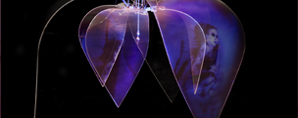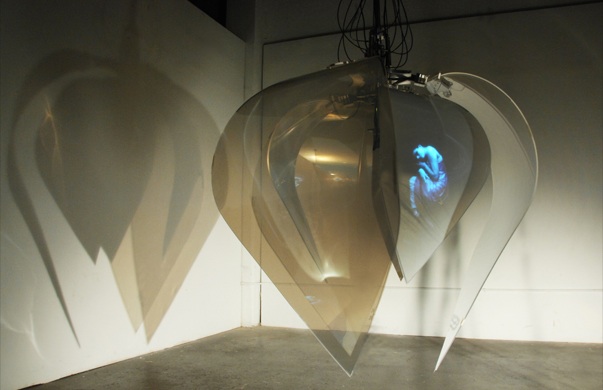CEREUS, Queen of the Night by Philomène Longpré
May 4–18, 2013
ELEKTRA International Digital Arts Festival, The PHI Centre – Montreal
Opening May 4, 4pm at The PHI Centre.
March 21-23, 2013
Visualizing Media Futures Symposium, Swarthmore College – Philadelphia
October 1-6, 2012 Black Box, Hexagram-Concordia – Montreal
CEREUS defies the constraints of the gravitational pull between heaven and earth, life and death, light and darkness. It presents a sensory exploration in the subversive spirit of the Lettrism movement. Digital interface, virtual character, robotic structure, and abstract sounds envelop the visitors, making them co-conspirators in the unfolding action. Inspired by the legends of the Papagos Native Americans, Philomène Longpré recreates a nocturnal world where stem-like machinery, cables and tubes operate a responsive video membrane, the heart of Cereus. Extract from CEREUS Exhibition Text: Cereus: Queen of the Night by Guillaume Evrard Over two hundred years ago, in the publication Species Plantarum, the Swedish naturalist Linnaeus described for the first time the night-blooming cactus Selenicereus grandiflorus. Today, the artistic practice of Philomène Longpré continues to explore the unknown and the mysterious by charting new artistic, physical, and sensorial territories. The bloom of the Selenicereus grandiflorusis fragrant, colorful, and alluring. Fresh and alive, thriving in the middle of the vast desert, once a year it unfolds to become the ‘queen of the night’. Sphinx moths, attracted to the irresistible scent of the flower during their nocturnal flights, embody the victory of lightness over gravity. Before dawn, the ephemeral queen succumbs to the force of attraction that connects us all to the ground and tumbles back to the earth that originally nourished her.
—
The inescapable pull of gravity on the human condition and its environment inspires Philomène Longpré’s Cereus. This interactive video system renews the iconography of a theme that has preoccupied mankind since its earliest days: from the ancient myth of Icarus to the dream of levitation by French artist Yves Klein. In the 16th century, Peter Bruegel’s painting The Fall of Icarus depicts the power of gravity, as Icarus plummets toward the sea, his feathers lost, while in the foreground, a shepherd tends his sheep and the farmer ploughs the field. This iconography portrays the unavoidable nature of gravity. The relationship between body and space, lightness and emptiness also fascinated Klein, who jumped into the void in 1960 and achieved momentary weightlessness. The boldness of the mythological hero finds an equal in the technological ambitions of Longpré. Using intricate computer programming and by developing innovative interfaces, she confronts both conceptual and technical challenges. Floating and pulsating, the interactive curved video membranes of Cereusmysteriously recall the air-filled sails of the boat captained by Icarus’ father, Daedalus.
—
Beyond artistic and physical explorations, Cereus elicits multi-sensory responses in a subversive spirit that is related to the Lettrism movement. Message and media re-appropriated, Cereus questions the role of the video screen, its operation, and its purpose. Is it just a showcase or is it an interface that can be used to exchange, to communicate? What is the content, the goal? Faithful to the Lettrist reassessment of cinematically established conventions, Philomène Longpré redefines the answers to these questions. Cereus requires the presence of the spectators to make the most out of the system. Digital interface, virtual character, robotic structure, video membranes, and abstract sounds from field recordings of nature envelop the visitors. The stems of the Selenicereus grandiflorus develop into mechanical cables and tubes, while the petals become sensitive membranes. Reproducing the movement of the nocturnal curiosity of the sphinx moth, visitors are attracted by the luminous night of Cereus. The replication of this natural phenomenon enables the Cereussystem to push the limits of the visual experience. Like the moths that first see the flower before they take possession of it; visitors observe the technical interfaces necessary for the robotic system to function and interact. The work blooms without a hitch and the precise distinction between its being and the spectator disappears as they are both implicit in the resulting metamorphosis.
—
As the painters of the Renaissance and their successors searched for techniques to overcome visual limitations and transcend the representational system and as Klein studied the saturation of the color blue to achieve a feeling of pure space, Philomène Longpré broadens the scope of possibilities. Cereus’ system presents a video environment rather than a simple display. It offers a multi-sensory experience based on the specific use of a sensitive membrane developed by Longpré, which responds to movements of a virtual character as well as to visitors through a complex set of sensors and reactive pistons. With Cereus, Longpré succeeds in defying the constraints of the gravitational pull between heaven and earth, life and death, light and darkness. Art historian, Guillaume Evrard has published several articles on the Relationship between visual arts, architecture and politics, especially in the context of universal and international exhibitions of the nineteenth and twentieth centuries.



